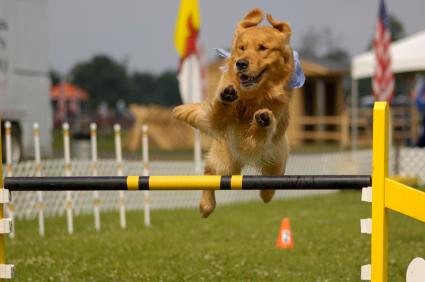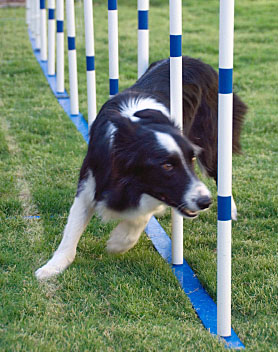|
Dog AgilityLooking for a fast and furious way to showcase your dog's speed, grace, and training? Agility may be just what you're looking for! Agility involves racing through a sort of 'obstacle course' off-leash, with no treats or toys as incentive, relying on verbal and hand signals, as well as body language, from their handler, as they're judged for their speed and accuracy in 'tagging' the targets. The handler is not permitted to make physical contact with the animal during the run.
The Obstacle Course The agility course consists of several 'obstacles'. Your dog must run the obstacles in a certain order and in a certain way. The course is usually about 100 feet by 100 feet, with the obstacles numbered in the order the entrant must negotiate them. Since the course can be complicated, the animal relies completely on the handler to 'navigate' him through the course correctly. Obstacle courses almost always contain at least one hurdle, weave poles (think of a slalom course for skiing), a tunnel or chute, and an 'A-frame' (two planks joined together at the top, and angled out to the sides) or a 'teeter-totter' which the animal must run up one side and pause for a split second while his weight causes the other side to drop down. This type of obstacle is engineered so that one side is slightly longer and heavier, and so will automatically flip back to the starting position after the animal leaves it. Sometimes, an obstacle course will have a ring suspended from ropes that he must jump through. Another obstacle that may be used is called a 'dogwalk' (kind of a balance beam for pups) that has an up ramp and a down ramp, with a level beam in between, elevated about 4 feet off the ground. You might also find a long tunnel that he zips through. The tunnel can either be fully opened or collapsed at one end, in which case your pet looks like he's emerging from a giant sock! Other items may include a 'pause table' or a 'pause box' where the entrant must sit for a specified number of seconds (the judge counts these) before taking off again. Since the setup of the obstacles may vary in different competitions, the handler is always given a map of the course before the competition and is allowed to 'walk the course' to plan out the best course of action.
The entrants that are competing in an agility contest are grouped by size and skill level. For instance, a novice Chihuahua going for his first 'run' wouldn't compete against a Border Collie who has already earned titles. Smaller dogs, although speedy, usually take longer to complete an agility course simply because their legs are shorter--and there's a lot of ground to cover with those little legs!! Sometimes there is also a category for 'juniors' (handlers under age eighteen). Competitors are judged depending on their speed, accuracy, and how well they follow their handler's directions. 'Faults', such as forgetting to touch the bottom of the A-frame in the correct spot when exiting, or entering the weave poles incorrectly (the dog must start with the first pole on his left and not miss any poles while weaving), will detract from the overall score. Border collies and Australian Shepherds are among the breeds that seem to excel at agility. Love Aussie Shepherds? Click here for lots of great info about this athletic, active breed.
Training for Agility Basic execution of obstacles is not difficult if you (or the handler) and your pet share a solid bond. Most dogs can be easily coaxed to run through a tunnel for a toy or treat; however, since equipment such as a teeter-totter or weave poles are unfamiliar to a pet (and therefore could be scary), these may take a bit more work. I've heard of a few techniques with the weave poles: Hold his collar and gently guide him through the poles as you hold a treat in front of him, or you could try teaching him to weave through only two or three poles at first, gradually adding until you've worked up to the complete twelve poles. Some trainers set up a 'barrier' so the dog is forced to weave through the poles. Each one of these techniques has merit; it all depends on what works best for your pet and is the most comfortable for both of you.
Different 'twists' on the basic agility run make the competition more interesting, particularly if a lot of entrants with advanced skills are competing. Here are some of the other games you might find: 1. Jumpers involves several different types of jumps or hurdles the dogs must perform in the correct order. A tunnel or weave pole may also be part of the course. Jumper courses are usually fast because there are no 'contact' obstacles to slow the competitors down. 2. Gamblers (also known as 'jackpot') which is an unnumbered course. The competitor has a very short window of time (about fifteen seconds!) to complete a set number of obstacles predetermined by the judge. There may also be a line that the handler may not cross during the run; this type of game requires a highly skilled dog and handler, since the animal may have to turn completely away from the handler during the run. 3. Relay (also known as 'teams') involves more than one dog competing with others as a team. Each pet and handler completes a part of the course and then may hand a baton to the next competitor on the team who will run the next section of the course. Again, this takes a highly skilled pet and handler to execute for speed and accuracy.
1. The American Kennel Club (www.akc.org) 2. North American Dog Agility Council (www.nadac.com) 3. United Kennel Club (www.ukcdogs.com)
|






